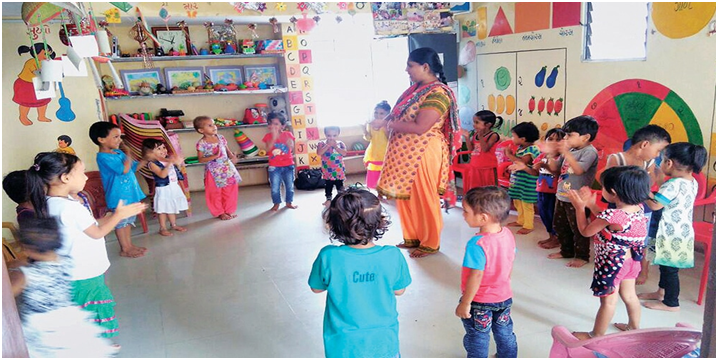Anganwadi centres as centres of learning (GS Paper 2, Social Justice)

Context:
- At the occasion of India@75, the Anganwadi system, part of the Integrated Child Development Scheme (ICDS) of the government which serves over 30 million children in the age group of 3-6 in 1.3 million centres across the country, should have been a triumph.
- The ICDS scheme is designed to support all children under six with their health, nutrition, and education needs; if done rightly, this would make India a leader in the next 25 years in early childhood education and deliver delayed demographic dividend.
- However, while across India over 70% of children are enrolled in Anganwadis, they are plagued by low attendance, parents simply do not perceive Anganwadi centres as centres of learning.
Parents’ perception:
- Parents’ perceptions of Anganwadisare shaped by how the system views them. In ICDS reports, parents are routinely addressed as “beneficiaries” — passive recipients of ration, immunisation camps, and lately, education.
- But this is not how parents view themselves or their children. Education for them is a gateway to meeting their aspirations, and a pathway to social mobility so that their children can have opportunities they missed out on. Enrolment rates for primary school reaching over 90% are a direct consequence of the link in parents’ minds that education leads to opportunities for a better life.
- However, the education ecosystem, including the early childhood care & education (ECCE)/ Anganwadi system, is not willing to speak parents’ language.
- In surveys conducted repeatedly with rural and urban parents of 3-6 year old children, over 80% of parents consistently tells that their kids’ best pathway for social mobility through education is via learning English (speaking and writing) and math skills. This is what they look for when they enrol and send their children to a learning centre.
Bottlenecks:
- Anganwadi systems, with the best of intentions, do not fulfil parents’ demands. The ECCE curricula for different States instead focus on local language-driven, and play-based pedagogy recommended by leading educators in India for this age group.
- They prescribe free and guided play-based, activity-based learning, facilitated by a skilled educator , without much thought given to how parents might perceive learning of this sort.
- Low attendance in Anganwadis is a tragedy for India’s children’s development. According to experts, the ideal preschool has a skilled facilitator who ensures that children spend most of their time in free and guided play.
- It includes exploring and manipulating their physical environments to develop early language, early numeracy, socio-emotional, executive function, and motor skills, at a rate of neuronal activity that they will never get back once they get older. The best Anganwadis in many States do look a lot like this.
- Staffed by Anganwadi workers with roots in play-based pedagogy, attending the Anganwadi for the prescribed two hours a day helps children build critical skills by playing with inexpensive, locally made, indestructible toys in a group setting.
Private preschool:
- However, by ignoring or belittling parents’ aspirations and demands, they have pushed parents to vote with their feet and leave the Anganwadi system. They are sending their children to the opposite of Anganwadi classrooms — to private preschools that are downward extensions of primary school.
- Here the 3-, 4-, and 5-year-old children sit in neat rows, practicing joyless, rote-based learning and memorisation of letters and numbers to the exclusion of all else. Over 7 million children in India attend these age-inappropriate private preschools that focus on rote learning from the earliest ages.
Importance of language:
- To support children in best manner, they have to start by not patronising parents and ignoring their powerful, expressed needs for English language skills, writing, and maths.
- This can be done in easy ways; exposing children to the English language at an early age in an age appropriate, non-intimidating way while recognising that the language spoken at home is the best way to reach fluency in any other language.
- Giving children a pencil to scribble for a few minutes a day, of course without making them write letters and numbers endlessly, is a great way to support fine motor skills and later writing.
- Exhibiting the wonder of maths through fun activities like estimation, comparison, sorting, and seriation could help reduce the fear and paralysis of maths that gets in their way of succeeding in STEM in later years.
Suggestions:
- Anganwadi centres can follow regular daily schedules that balance time spent on self-directed free play and teacher-led activities focused on developing cognitive, literacy and numeracy skills.
- They can also conduct regular ShikshaChoupals (parent - teacher meetings) to showcase the learning happening in the Anganwadi to the parent community to bolster their trust in this institution. Additionally, regular messages can be shared with the parents to equip them on the nature of engagement expected from them to maintain the momentum of what is learnt at school.
- However, changing ECCE curricula to make room for parents’ mindsets in the short term does not mean accepting mindsets or perceptions as a given in the long term, especially as they relate to genuinely unproductive practices like rote-based, memorisation-heavy learning at the early ages.
Way Forward:
- There is sufficient empirical evidence of mindset change from education’s own “School Chalen Hum” to the Swachh Bharat Abhiyaan campaign, that one can change minds and behaviours with sustained action and mass campaigns.
- A mass campaign for awareness of age appropriate ECCE that brings parents in as stakeholders, is crucial in the next five years.
As the nation celebrates the joyous occasion of India@75, Prime Minister has iterated that the spirit of AzaadikaAmritMahotsav is establishing ‘jan-bhagidari’ (participation of citizenry) for activating India 2.0. In the ECCE ecosystem, there is need to embrace the power of ‘abhibhavaak-bhagidari’ (participation of parents) to activate Anganwadi 2.0.


